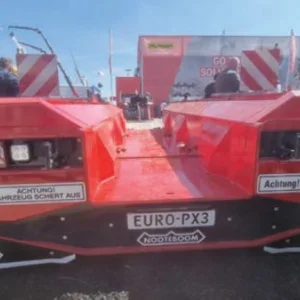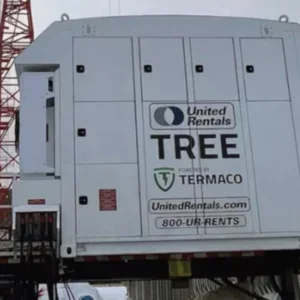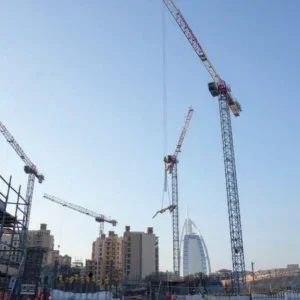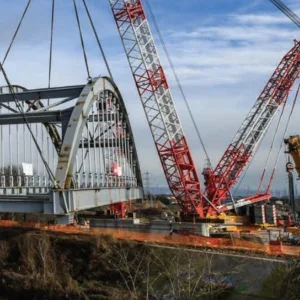Industrial cranes, yard cranes, carrydecks, pick & carry cranes – there are various terms to choose from. And when it comes to low-profile mobile cranes designed for running around factory yards with a load and moving inside, perhaps to install machinery, there are plenty of different products on offer.
In North America Broderson appears to still lead the way, although it does not report its figures to the manufacturers’ organisation, so there is no way to verify that. Up against Broderson is Grove – with its new YardBoss range – as well as Shuttlelift and Galion. Lift Systems and Favelle Favco, a new entrant, are also in this market. And a low-cost industrial crane/rough terrain hybrid is offered by Terex that may appeal for certain applications.
In Europe Ormig and Valla are leading names in this sector, while a third Italian company, Bencini, is marketing its less compact electrically-powered industrial mobile cranes.
Other names to note are the Australian-built Franna cranes and the Indian manufacturers TIL and Escorts.
Broderson’s industrial crane standard range comprises the IC-35-2B, the IC-80-F and the IC-200-C. The IC-35-2B, the smallest of the three, picks 8,000lb (3.6t) through 360O on outriggers and 5,000lb (2.3t) on its rubber tyres. The mid-range IC-80-F lifts a maximum 17,000lb (7.7t) on outriggers. The IC-200-C lifts 30,000lb (13.6t) on outriggers and 16,500 (7.5t) on rubber – again, all through 360O.
A prototype IC-200-3C was shown at the Conexpo show in Las Vegas earlier in the year. It differs from the IC-200-C mainly in that it has a fully proportional four-section boom instead of three-section, offering 66ft (20.1m) of horizontal reach instead of 51ft and maximum tip height of more than 73ft (22.3m) instead of 60ft. Petrol, LPG, dual fuel or diesel power are all available.
Specifications of Broderson’s top industrial crane are not dramatically different from its smaller rough terrain models. The key differences being that the IC models have solid mounted front axles and limited oscillation at the rear, and have smaller chassis making them better suited for confined areas such as warehouses and factories.
Grove Crane launched its 8t and 10t YardBoss carrydeck cranes (the YB 4408 and YB 4410) last year and this year added a 15t model to the range. The YB 4415 has 9t pick and carry capacity, features a choice of 2- or 4-wheel drive and all-wheel steering, and has a standard 12.2m, three-section full power boom. A 15.6m boom will be available soon, Grove says, and a 4.6m extension can be added to either boom, fixed or offset to 45O to enhance up-and-over reach capability. The pivoting boom head is designed to make the most of limited headroom and it has a low profile anti-two block device. Petrol, LPG or diesel power are available.
Grove says that the YB 4408 and YB 4410 are in distributors’ rental fleets and are increasingly prevalent in the fleets of the larger rental companies. Grove is also preferred supplier for the Caterpillar equipment rental stores, which bodes well for the future.
Shuttlelift has brought out two new models this year: the 3340 and the 7750. The 3340 has a rated lift capacity of 18,000lb (8.2t), and the 7750 lifts 40,000lb (18.1t). Together with the earlier 3330E and longer boomed 3330ELB, they comprise Shuttlelift’s industrial carrydeck range, though rough terrain carrydeck models such as the 15t-capacity 5560 RT are also offered. As with Broderson’s crane range, the RT models differ by not having rigid axles, and four-wheel drive is not standard.
The 3340 has a three-section fully proportional boom which extends from 3.5m to 9.3m, and with extensions offers a total reach of 14.8m. The five-section boom on the 7750 extends from 4.9m to 19.4m and can reach 24.5m with swing-around extension.
Galion is a good traditional brand, but only one model is manufactured today – the 150FA. Production was shifted this year from Galion, Ohio to the Chattanooga, Tennessee manufacturing facility of the brand’s owner, Komatsu America International Company. About 120 units are shipped worldwide each year, says Komatsu.
The diesel-powered Galion 150FA has a capacity of 30,000lb (13.6t) and comes with either a three-section or a four-section boom, to give a maximum horizontal reach of 37ft 6in (11.4m) and 60ft (18.3m) respectively. Adding a jib to the four-section boom increases reach to 80ft (24.4m).
With a height of more than 11ft (3.4m), the Galion is a much less compact machine than the Broderson equivalent, for example, but Komatsu says that the crane “has been very well accepted in the petroleum processing industry and in manufacturing”, and adds that “one of the best liked features is the automatic two-block protection”.
Lift Systems made its name with hydraulic gantries rather than mobile cranes but its Mobilift range includes the 10 US ton (9t) M10 carrydeck crane, and 45 US ton (40.8t) and 55 US ton (49.9t) models. Lift Systems claims that the M10 is “the most compact 10 ton carrydeck available, at only 6ft 10in high by 6ft 5in wide”. In metric terms, these dimensions are 2.08m high by 1.96m wide. It features side shifting on outriggers when crab steering does not provide enough manoeuvrability.
New to this market is Favelle Favco Cranes (USA), on whose stand at Conexpo could be seen for the first time various cranes including the FFC 9T, with a rated capacity of 18,000lb (8.2t) through 360O. Deck capacity is 5000lb (2.0t). The three-section boom extends from 6.7m to 17.1m. Fixed or telescopic swing-around jibs are optional, enabling a maximum tip height of 29.9m with the latter.
Most of the aforementioned cranes are visually distinguishable from small rough terrain cranes by the position of the cab, midway between the two axles rather than at the front. Thus the new Terex CD 200 series should probably not strictly be considered in this category. But this cab down rough terrain crane, with lifting capacities ranging from 18t to 23t, is likely to have some purchasers in the industrial sector as well as in construction. Though a bigger crane than some of the “pure” yard cranes, four-wheel and crab steer aid manoeuvrability.
Valla’s extensive range comprises 15 standard models, more than half of them electrically powered. They range from the small 2t-capacity 20E, behind which the operator walks, to the 40t-capacity 400E.
Ormig’s pick and carry range is from 9t to 45t. Two electrically-powered models are available, the 9tmE and the new 33tmE, with capacities of 9t and 33t respectively. The diesel-powered and electrically-powered versions of these machines sell in broadly equal numbers, Ormig says. Ormig also has a range of all-terrain cranes and reach stackers but, judging by where its marketing efforts are concentrated, its line of yard cranes is where the company currently scores best on the world market. Most sales are in Europe but North America is also now being targeted.
A third Italian manufacturer, Bencini, is marketing an electrically-powered, 10t-capacity mobile crane, as seen at the Samoter show in Verona, Italy in February.
Franna’s range of pick and carry cranes comprises models of 14t, 18t and 25t load capacities. In December last year the Australian manufacturer delivered its 1,000th crane since the inception of the company by Lou Parolin and Brian Hain in 1986. New this year is the UC-10, an articulated two-wheel drive utility crane with a full-width cab and a rear-mounted engine.
Escorts Construction Equipment has six pick and carry yard cranes in its range, with lifting capacities ranging from 5t to 18t, and makes about 550 units of these a year. TIL has a similar range, including the 10t-capacity TLM-10, also known as the Little Bull, which is based on a design by Linmac of Australia (Linmac design returns home Jul98, p11).
On top of all of these cranes, there are a host of forklifts and telescopic material handlers that can be fitted with a hook that some users may prefer. A 10m telehandler, equipped with a 2t winch, may gain in versatility what it lacks in lifting capacity.






